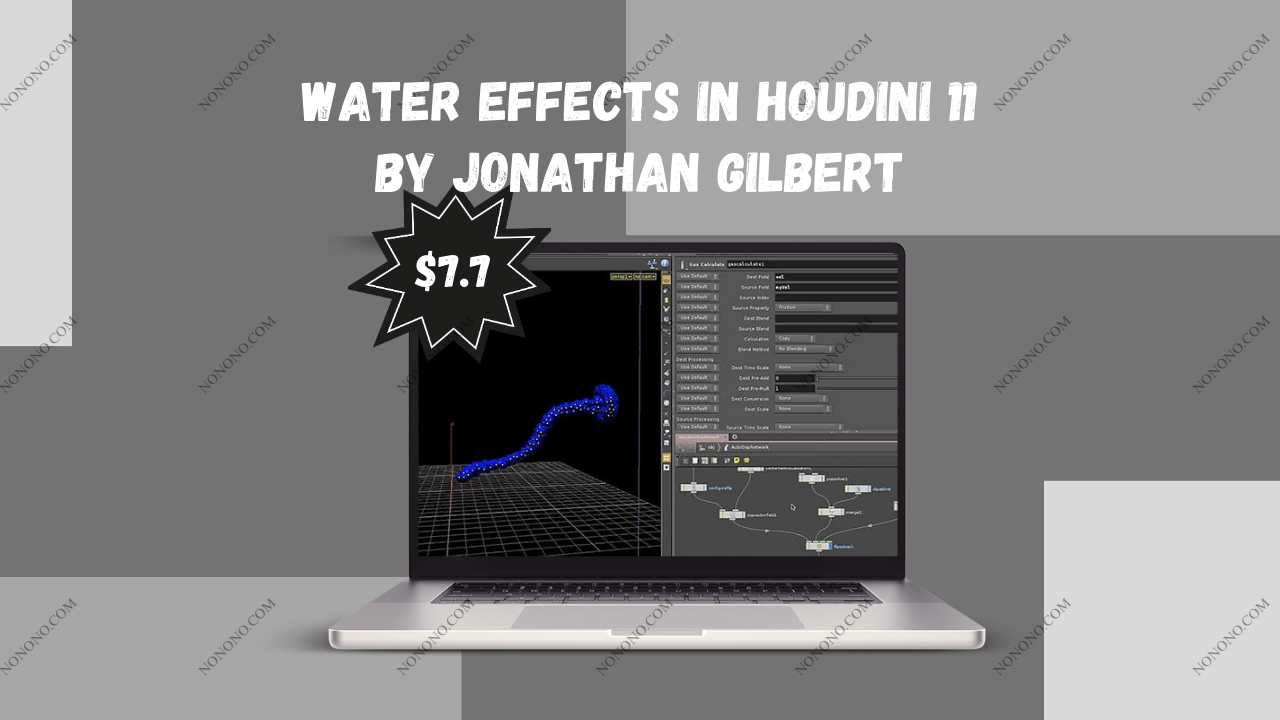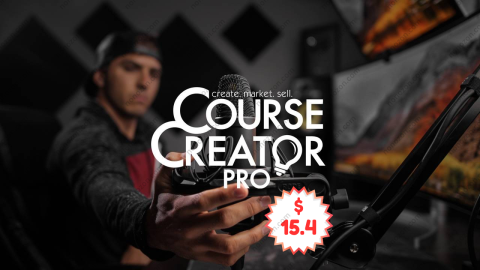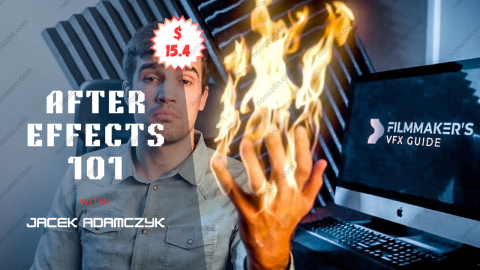Water Effects in Houdini 11
by Jonathan Gilbert
Water Effects in Houdini 11 by Jonathan Gilbert For Digital Download!
Check Proof of Content here:

Water Effects in Houdini 11: A Comprehensive Review by Jonathan Gilbert
Simulating realistic water effects is a crucial talent for artists and animators in the ever-evolving field of computer graphics. For beginner to advanced users, the course "Water Effects in Houdini 11," taught by the renowned Jonathan Gilbert, offers a priceless chance to explore the complexities of fluid simulations in the popular program Houdini. This extensive 11-hour course, which is offered by FXPHD, covers a wide range of fluid dynamics-related topics and guarantees that students can produce realistic and engaging simulations. Students are assured of a rich educational experience that blends theory with practical projects, with an emphasis on three main types of fluid simulations: voxel-based fluids, FLIP (Fluid-Implicit Particle), and SPH (Smoothed Particle Hydrodynamics).
The curriculum is perfect for individuals who want to improve their abilities in this field because it is carefully crafted to lead participants through both fundamental and complex ideas. In order to foster a collaborative learning environment, students will engage with both Jonathan Gilbert and his co-instructor, John Moncrief, as they progress through the course. In addition to outlining the abilities you can acquire to improve your water simulation creativity, this post will examine the course's structure, essential elements, and possible advantages.
Overview of the Course
The course starts with an introduction to fluid dynamics, where students study the basic ideas underlying fluid behavior and the various kinds of fluid effects utilized in animation. The versatility of the FLIP solver, which is well-known for its accurate depiction of liquid behavior, is highlighted in this section. The lecturers lay a strong basis for more complicated subjects by offering insights into how fluid simulations work. It is essential to comprehend these fundamentals since they are the foundation for more complex methods.
The course moves on to creating simulations after students have a firm understanding of the foundational ideas. Volume, SPH, and FLIP fluids are among the simulation types covered in this section. The lecturers carefully go over crucial parameters that have an impact on realistic results, showing how to modify these settings to get the appropriate fluid dynamics in a variety of situations. Because the nature of fluid behavior can change greatly depending on user choices, the environment, and interactions with other elements in a scene, this information is essential.
After laying the theoretical foundation, the course presents fluid simulation customization methods. Students experiment with emission and collision geometry configurations, which improves their capacity to produce original and intricate simulations. Gilbert and Moncrief encourage participants to try out diverse situations, which cultivates an innovative and creative mindset that is necessary for any artist who wants to push the limits of conventional methods.
Secondary Effects in Fluid Simulations
An exciting aspect of the course is its focus on secondary effects, which play a pivotal role in elevating the realism of fluid simulations. These effects include phenomena like floating leaves, splashes, and sprays. The lessons in this section are tailored to teach methods for generating these effects seamlessly, allowing artists to integrate them into their projects without disrupting the primary fluid dynamics. The inclusion of secondary effects not only enhances visual appeal but also brings life to the simulations, creating a more immersive experience for viewers.
In this context, several techniques are highlighted, such as leveraging particle systems to emulate natural floating debris or using field forces to manipulate water interactions artistically. Each of these lessons is designed to build on previous knowledge and make the learning process engaging and relatable. The practical applications of these techniques can lead to stunning results, vastly improving any artist’s project and refining their skill set significantly.

Techniques for Rendering and Compositing
Lessons on rendering and compositing come at the end of the semester after students have mastered secondary effects and fluid simulations. In this session, participants learn the fundamentals of lighting, shading, and Nuke compositing techniques. The finalization of fluid simulation projects and their flawless integration with live-action backgrounds are the main topics of this crucial part. Any aspiring artist must have a firm understanding of rendering, which is frequently regarded as one of the most difficult phases in the animation process.
Participants get an understanding of how light interacts with water surfaces to produce reflections, caustics, and other aesthetically pleasing features through the rendering techniques covered in this course. This understanding also includes the usage of shaders designed for fluid effects, which enables students to create better images that are noticeable in productions and portfolios.
Additionally, the compositing techniques covered in this course allow artists to seamlessly incorporate computer-generated components into live film, which is an essential ability for anybody interested in visual storytelling. Through the combination of live-action filming and the simulated aspects, participants are given a fresh viewpoint on how to carefully integrate different media forms to improve storylines.
Project-Based Learning Environment
"Water Effects in Houdini 11" is notable for its focus on production-oriented tasks. A project that requires incorporating a computer-generated water fountain into a live-action backdrop is available for participants to work on. This practical method gives students the opportunity to experience real-world application while also reinforcing the academic knowledge they have learned throughout the course.
Participants gain the self-assurance and abilities needed to take on increasingly challenging simulations in the future by working on projects of this nature. By emphasizing the value of real-world application, the teachers encourage students to take chances and try out the skills they have learned. Students should have a portfolio piece by the end of the semester that highlights their newly acquired skills, increasing their marketability in the fiercely competitive visual effects field.
Intrinsic Value of Practical Application
The intrinsic value of this course lies not just in the technical skills taught but also in the course's ability to foster creativity, critical thinking, and problem-solving. As participants engage with each segment from the basics of fluid dynamics to advanced rendering techniques they are encouraged to think beyond standard practices and explore their unique artistic styles. This freedom is vital for artists, as it encourages a sense of ownership over their work and inspires innovative thinking.
Moreover, the course nurtures a community among learners, with opportunities for collaboration and sharing insights with fellow students and instructors. This interaction fosters networking and a sense of camaraderie, further enriching the learning experience. In an industry where collaboration can lead to breakthrough projects, the relationships and connections formed during the course can be invaluable.
Conclusion
To sum up, Jonathan Gilbert's "Water Effects in Houdini 11" provides a thorough and captivating examination of fluid dynamics for anyone wishing to improve their abilities. The course stands out as a crucial resource for beginner to advanced users because of its well-organized curriculum, practical projects, and emphasis on both fundamental and sophisticated approaches. This course is a thorough guide that will help you build beautiful water effects, incorporate them into live-action videos, or just learn more about what Houdini can do. In the end, the information and abilities acquired here have the potential to revolutionize your approach to fluid simulations, creating new avenues for imaginative narrative and inventiveness in your work.
Related products

Course Creator Pro (Preview) - Lifetime Updated
by FullTime Filmmaker Team
$15.40



